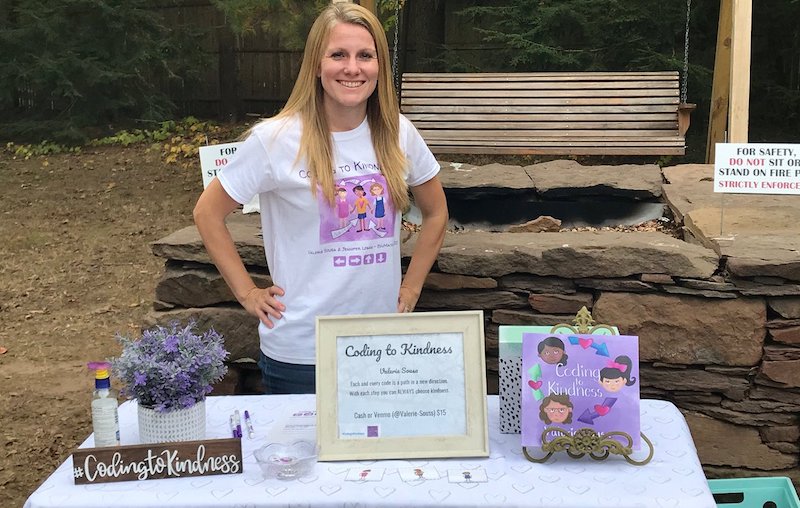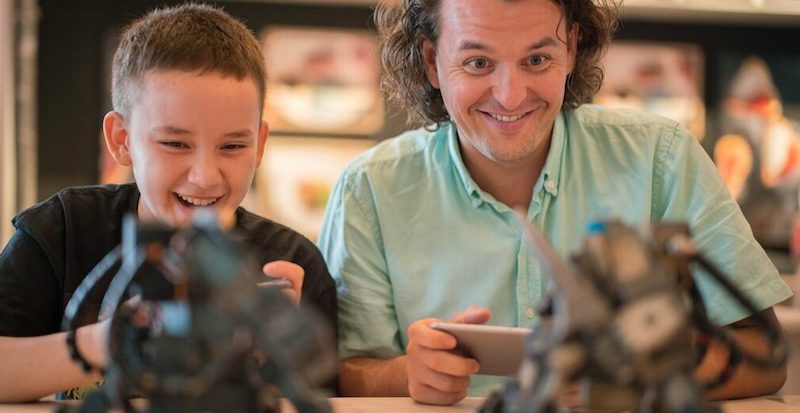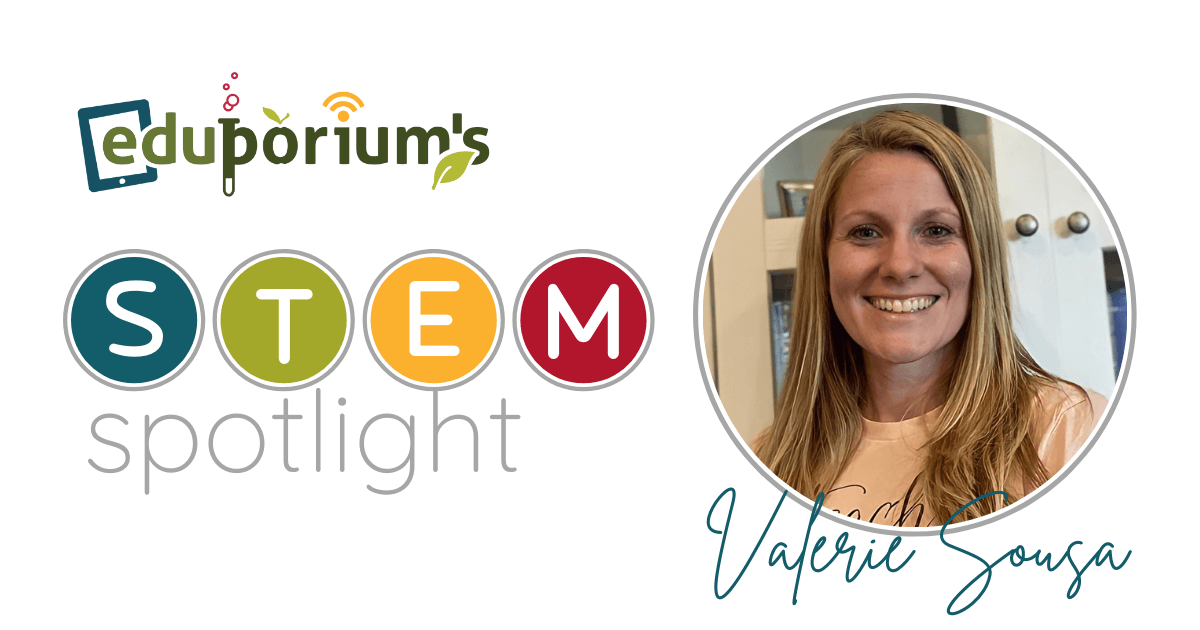Our STEM Spotlight series continues with this latest feature on Valerie Sousa. Valerie is an author, educator, and huge proponent for STEM education. Over the years, she has helped lead hands-on STEM learning experiences for students and also helped expand their minds by sharing some of her favorite STEM-related books. Whether it's hands-on coding experiences or simply stimulating creative thoughts, Valerie definitely believes in the power of collaboration and community in helping kids prepare for the future. Check out the rest of her thoughts below!
1. What inspired you to get into the STEM education field?
I have taught kindergarten for 12 years. Over the course of the 12 years, I've seen so much change with STEM and technology. Our world is changing so fast and I felt that my students needed exposure to more of what the world around them is actually like. I teach my young students basic coding skills and have a makerspace set up in the classroom for them to explore, create, build, and invent new things.

2. If you were designing the ideal STEM space, what are the 3 must-have items that you would need to include?
First on the list is definitely cardboard! It's amazing what you can do with cardboard. Students can build, invent, and create so many wonderful things with something that is free! Any free materials are ideal for a makerspace, really. The second thing I would say is to incorporate a mix of both tech and non-tech coding activities. My absolute favorite is Learning Resources: Code and Go Robot Mouse Activity Set. Scratch Jr. is another wonderful free app that students can use to practice coding in a fun and exciting way. The full Scratch platform is also a great expansion of Scratch Jr. once they get older and have some familiarity with coding.
Next, I would say that read alouds are certainly something I've found to be effective in helping inspire student creativity. Some of my favorites are 'Rosie Revere Engineer' by Andrea Beaty, 'One Plastic Bag' by Miranda Paul, 'The Boy Who Harnessed the Wind' by William Kamkwamba and Bryan Mealer, 'What Do You Do With An Idea?' by Kobi YamandaIf, 'I Built a School' by Chris Van Dusen, 'How to Code a Roller Coaster' by Josh Funk, 'How to Code a Sandcastle' by Josh Funk, and 'Big Engineering Experiments' for Little Kids by Jacie Maslyk.
3. How do you see the skills learned from STEM and EdTech applied in other subject areas?
I see technology as a way to help students enhance their academic skills. Students are given many different opportunities to connect tech tools with the skills they're learning and technology helps allow students who once may not have had in-depth access to the curriculum gain that all-important access through multiple modalities of learning. Students view academic skills through a different lens because STEM has changed how many of them tackle problems. If regularly exposed to STEM over time, they start to learn to tackle problems creatively and STEM, without a doubt, helps them develop a growth mindset and grit.
4. Based on your knowledge/experience, what are some of the most in-demand skills today’s students should be developing?
I think that problem solving is the No. 1 skill, in terms of importance, that students learn through STEM experiences. Problems are always going to arrive in our students' lives. Giving them opportunities to think creatively, work together, and show patience to themselves and others are lifelong skills that will help them in their professional and personal lives.
5. Do you think—on average—they have access to learning that effectively helps them build these skills?
I think they do but, if I were to be honest, this sometimes gets brushed aside due to mandates, testing, and curricula that do not necessarily hone in on this style of learning. Because of this, it often takes a conscious effort from the teacher, but it's still very much possible. I see more and more STEM enrichment teacher, media specialist, and STEM coach positions being created in more and more districts. To me, this is what makes a positive impact on students and can be a tremendous support to the teachers.

6. Do you have any thoughts on how STEM tools could help kids build a strong SEL foundation?
This is exactly where my heart lies—at the intersection between STEM and SEL. The majority of my work in STEM centers on connecting it with SEL skills. I teach kindergarten and these students are at the perfect age to learn to self regulate, explore their feelings, connect with peers, and work collaboratively. I love coding because of this. It allows for students to problem solve, make mistakes, learn from mistakes, work together, show patience, politely agree and disagree, and so much more.
This all happens authentically when doing any partner, small group, or whole group coding activities. I was so inspired by the powerful SEL connections I saw my students make while coding that I published a children's book titled 'Coding to Kindness' for teachers and parents. I use the book and many lessons throughout the year as a way to help my students learn to code and learn the foundational SEL skills they'll need in order to thrive. If any teacher or parent wants to learn more, I have free resources on my website.
7. What are some of the strategies you know to be successful in helping students develop Future Ready skills?
I think the most important strategy when introducing STEM concepts in my classroom is remembering that I don't have all the answers. I continually make mistakes and grow alongside my students. Like many others, I didn't necessarily wait to feel 100 percent comfortable or knowledgeable in this new area before starting to teach it. I did my research and prepared but dove right in. It showed my vulnerability and also how no skill is perfected after only the first time we focus on it. I think this brought a sense of increased easiness to the classroom with myself and my students feeling increasingly comfortable with being creative, speaking up, correcting one another in a kind way, and genuinely working together to get the best outcomes.
8. Based on any industry knowledge, what are some trends you see becoming prominent in STEM education?
I see early childhood and elementary educators taking the leap with coding and introducing it in their classrooms. In my opinion, more and more students at a younger age will be exposed to these opportunities. I also want students to have more opportunities to think creatively, build, invent, and create new ideas, models, and designs. We've done this a bit using 3D printers, makerspace materials, and so many other building toys and objects. I have seen and hope to see more of these two things being combined to solve many of our world's problems and make the world a better place.
We thank Valerie for sharing her thoughts on STEM education with us and with our community. To follow more of her work, check out Coding to Kindness on EduMatch and follow her on Twitter and Instagram. To learn more about the importance of STEM education for today's students and teachers, we encourage you to check out the rest of our blog. Feel free to reach out to us with any questions or to share your own story and follow us on Twitter and Instagram for more.



